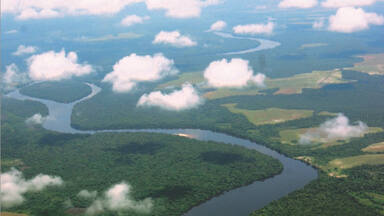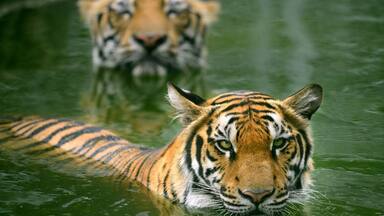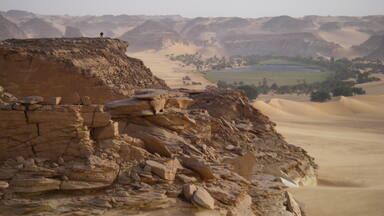Manovo-Gounda St Floris National Park
Manovo-Gounda St Floris National Park
The importance of this park derives from its wealth of flora and fauna. Its vast savannahs are home to a wide variety of species: black rhinoceroses, elephants, cheetahs, leopards, wild dogs, red-fronted gazelles and buffalo, while various types of waterfowl are to be found in the northern floodplains.
Description is available under license CC-BY-SA IGO 3.0
Parc national du Manovo-Gounda St Floris
L'importance de ce parc tient à la richesse de sa flore et de sa faune. Ses vastes savanes abritent des espèces de mammifères très variées : rhinocéros noirs, éléphants, guépards, léopards, chiens sauvages, gazelles à front roux, buffles, et différents types d'oiseaux aquatiques qui trouvent un habitat dans les plaines d'inondation du Nord.
Description is available under license CC-BY-SA IGO 3.0
منتزه مانوفو غوندا سانت فلوريس
تعود أهمية هذا المنتزه الى غنى ثروته النباتية والحيوانية. فسهول السافانا الشاسعة التي يتألف منها تأوي أصنافاً فائقة التنوع من الثدييات كوحيد القرن الأسود والفيلة وفهد الغيبار وفهد الليوبار والكلاب البرية والغزلان الصهباء الجبين والجواميس ومختلف أصناف الطيور المائية التي تجد لنفسها مسكناً في سهول الفيضانات الشمالية.
source: UNESCO/CPE
Description is available under license CC-BY-SA IGO 3.0
马诺沃贡达圣绅罗里斯国家公园
这个国家公园的重要性在于其丰富的动植物物种。公园广阔的大草原是许多物种的家园:黑犀牛、大象、印度豹、美洲豹、野狗、瞪羚、野牛等,而在公园北部的沼泽地则栖息着各种各样的水禽。
source: UNESCO/CPE
Description is available under license CC-BY-SA IGO 3.0
Национальный парк Маново-Гоунда–Сен-Флорис
Ценность этого парка связана с его богатой флорой и фауной. Обширные саванны служат местообитанием для самых разных животных: черных носорогов, слонов, гепардов, леопардов, гиеновых собак, краснолобых газелей, буйволов. А влажная местность на севере привлекает массу водоплавающих птиц.
source: UNESCO/CPE
Description is available under license CC-BY-SA IGO 3.0
Parque nacional del Manovo-Gounda St.Floris
La importancia de este parque se debe a la riqueza de su flora y fauna. Sus vastas sabanas ofrecen refugio a una gran variedad de mamíferos –rinocerontes negros, elefantes, leopardos, onzas, perros salvajes, gacelas frentirrojas y búfalos– y las llanuras inundables de la zona norte albergan diferentes tipos de aves acuáticas.
source: UNESCO/CPE
Description is available under license CC-BY-SA IGO 3.0
マノヴォ-グンダ・サン・フローリス国立公園
source: NFUAJ
Manovo-Gounda Nationaal park Sint Floris
Dit nationaal park omvat een totale oppervlakte van 1.740.000 hectare en is belangrijk vanwege zijn rijkdom aan flora en fauna. De uitgestrekte savannes zijn de thuisbasis van een grote verscheidenheid aan diersoorten: zwarte neushoorns, olifanten, cheeta’s, luipaarden, wilde honden, gazellen, krokodillen en buffels. In de noordelijke uiterwaarden zijn verschillende soorten watervogels te vinden. In de regio van Sint Floris zijn 320 vogelsoorten geïdentificeerd, waarvan ten minste 25 soorten roofvogels zoals de Bataleur en Afrikaanse zeearend. In het gebied komen grote seizoensgebonden populaties voor van de pelikaan en de maraboe ooievaar. Het park is daarnaast belangrijk voor watervogels en steltlopers.
Source: unesco.nl
Outstanding Universal Value
Brief synthesis
With an area of 1,740,000 ha, Manovo-Gounda St Floris is the largest park in the Central African savannas. Straddling the two ecological zones, Manovo-Gounda St Floris National Park owes its importance to its rich flora and fauna. It is home to many endangered species including the black rhino, elephant, hippopotamus and red-fronted gazelle as well as large concentrations of herbivores.
This Park is an interesting example of a “crossroads” where the species from savanna communities of East and West Africa, as well as those of the forest communities of the South, cross paths. The Park is a valuable area for the study of environmental changes occurring throughout the Sahel and Sudan under pressure from drought and overgrazing.
Criterion (ix): The Manovo Gounda St Floris National Park contains extraordinary natural formations. The Park straddles the Sudano-Sahelian and Sudano-Guinean biogeographical zones. This results in a variety of habitats from grassy plains in the north to savannas with gallery forests in the south. The property encompasses the entire watershed of three major rivers (Manovo, Koumbala and Gounda) with grassy floodplains and wetlands. The plains are interspersed with small granitary inselbergs with, to the south, the rugged sandstone massif of the Bongos.
This vast Park, surrounded by hunting areas and with a functional corridor to the National Park of Bamingui-Bangoran, protects the largest savanna of Central Africa. It represents a unique example of this type of ecosystem, home to viable populations of different species typical of this part of Africa and others from East and West Africa.
Criterion (x): The Park’s wildlife reflects its transitional position between East and West Africa, the Sahel and the rainforests. It contains the richest fauna of the country including about 57 species of mammals that have been well protected in the past. In this respect, it resembles the rich savannas of East Africa.
Several important large mammal species in terms of conservation live in the Park, such as black rhino, elephant, hippopotamus, red-fronted gazelle (here at the southern limit of its range), lion, leopard, cheetah and wild dog. There are large concentrations of herbivores, including buffalo, Buffon’s kob, waterbuck, and red hartebeest. Some 320 species of birds have been recorded in the Park, of which at least 25 species of raptors. Flood plains to the north of the Park are largely adequate for water birds, and the shoebill has been observed in the Park.
Integrity
With a total area of 1,740,000 ha, the Park is almost completely surrounded by the game reserves of Ouandija-Vakaga and Aouk-Aoukalé (480,000 ha and 330,000 ha respectively), which provide effective protection against threats to the property from surrounding areas. Other hunting areas and reserves are also connected with the property, resulting in a contiguous area of 80,000 km2 of protected areas. The property is large enough to ensure species viability.
Nevertheless, the integrity of the Park is a cause for concern because of the numerous threats, poaching in particular (notably of rhinoceros, elephant and giraffe) and grazing. The lack of protection and land management measures was also noted at the time of inscription of the property.
Protection and management requirements
The site has National Park status. It is governed by the 1984 Wildlife Protection Code on which the national legislation on the management of protected areas is based. At the time of inscription, the Park was managed by a private company (Manova SA) which benefited from a governmental contract to manage the site. The Park was then regarded as the best-managed protected area of the country.
Today, conservation is under the authority of the Ministry of Water and Forests, Hunting and Fishing, with a structure consisting of the Chief of Staff, the Director-General of Water, Forests, Hunting and Fishing, the Director of Wildlife and Protected Areas, the regional directors, site managers and national conservators. Two bases (Manova and Gordil) are situated alongside the Park, to the east and west, but only the former is truly functional. Anti-poaching actions are primarily organised from these bases, limited by the lack of personnel, means of transport and the prevailing insecurity in the Park.
The region is sparsely populated. However, nomad pastoralists from the Sudanese region of Nyala and from Chad, with 30 – 40,000 head of cattle, enter the Park every winter – the dry season grazing halt on their traditional seasonal migration routes. There is also dispersed and limited agricultural activity in the environs of the Park.
The pressures of poaching and grazing highlight the need for a functional management or development plan for the Park. This plan should take into account the zoning of the Park and its relationship with the Village Hunting Zones in the periphery, with participative management and a Development Plan for the entire north-east territory (grazing areas and redefinition of the seasonal migration corridors).
The creation of a transborder “Zakouma National Park (Chad) –Manovo Gounda St Floris National Park” protected area is also desirable.





